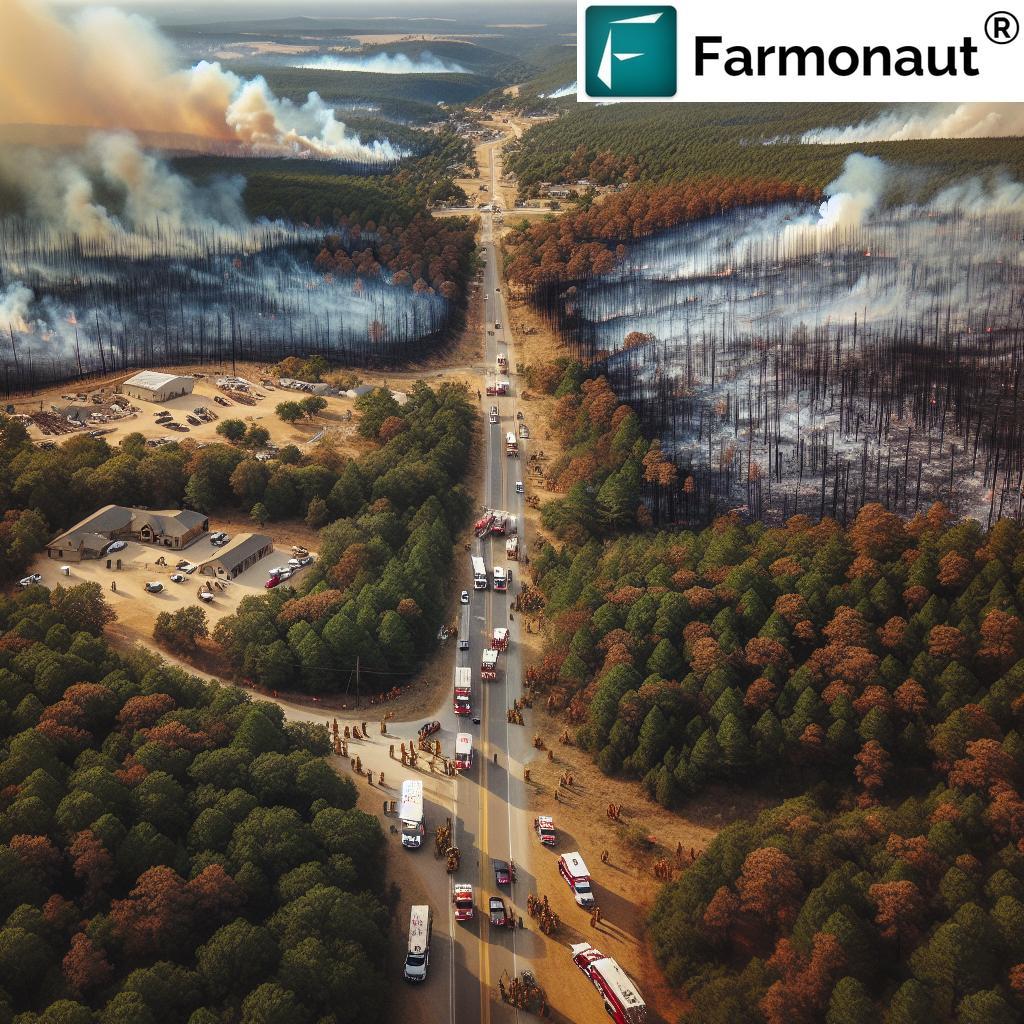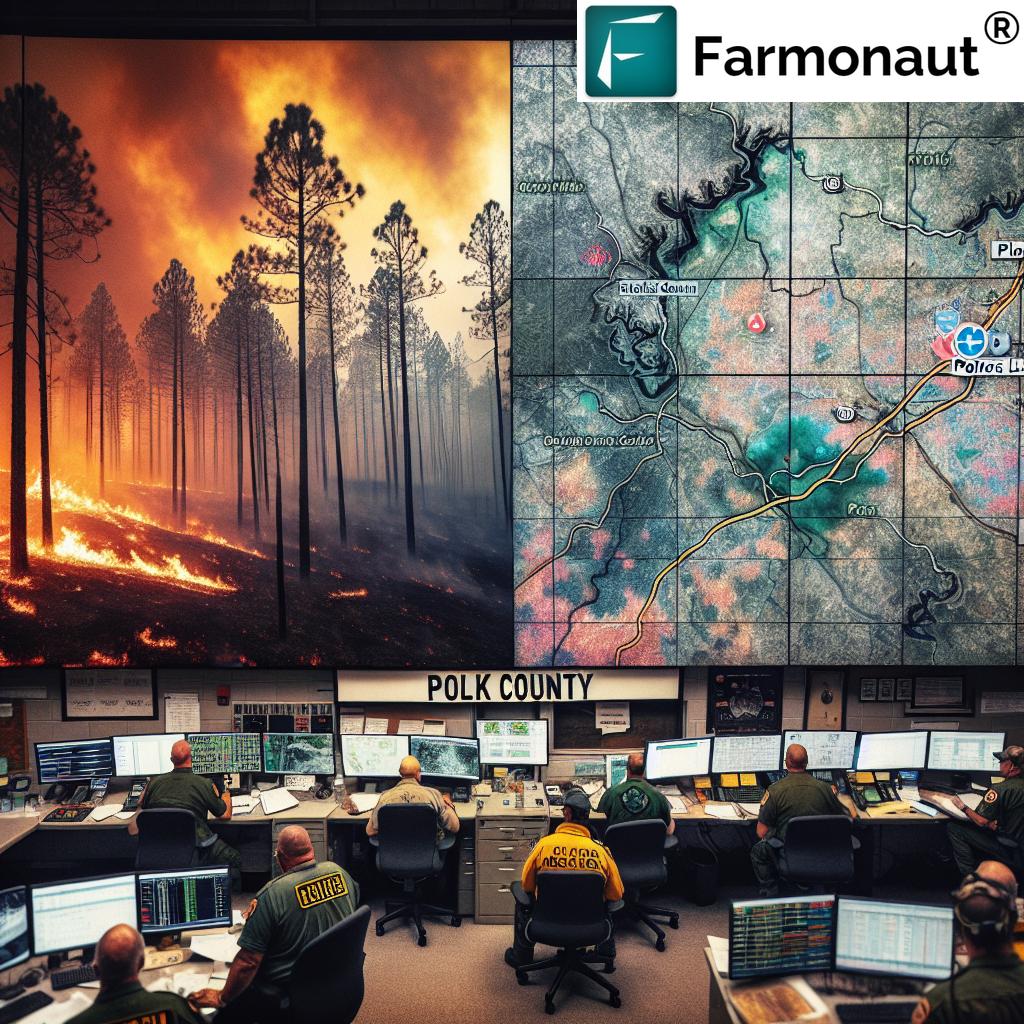Urgent: Polk County Wildfire Crisis – Emergency Preparedness and Evacuation Procedures for Carolina Residents
“The Black Cove Fire Complex in Polk County, NC has triggered emergency evacuations affecting thousands of Carolina residents.”
As we face the ongoing wildfire crisis in Polk County, North Carolina, our community stands united in the face of adversity. The active Black Cove Fire Complex has thrust our region into a state of emergency, necessitating swift action and comprehensive preparedness. In this critical time, we aim to provide you with essential information on wildfire safety tips, evacuation protocols, and community support initiatives to help protect lives and property during this challenging Carolina wildfire season.

Understanding the Polk County Wildfire Situation
The wildfires in Polk County have rapidly escalated, prompting local authorities to declare a state of emergency. Crews are actively responding to three wildfires that collectively form the Black Cove Fire Complex. This crisis is exacerbated by several factors:
- Dry weather conditions persisting across the region
- Millions of trees knocked down by Hurricane Helene last year, creating additional fuel for fires
- An extended and active fire season in the Carolinas, as noted by forestry experts
The impact of these wildfires extends beyond immediate safety concerns, affecting daily life and requiring coordinated response efforts from multiple agencies and communities.
Emergency Response and Evacuation Orders
Local governments and emergency services are working tirelessly to manage the wildfire crisis and ensure public safety. Here’s what you need to know:
- The City of Saluda is under a level 1 ready state of evacuation
- Residents in affected areas should be prepared to evacuate at short notice
- Henderson County has declared a State of Emergency due to the spreading wildfires
- A county-wide burning ban remains in effect to prevent further fire outbreaks
It’s crucial for all residents to stay informed about the latest developments and follow instructions from local authorities promptly.
Emergency Preparedness Checklist
To help our community prepare for potential evacuations, we’ve compiled a comprehensive emergency preparedness checklist. This table outlines essential items you should have ready in case of an evacuation order:
| Item | Quantity | Notes |
|---|---|---|
| Water | 1 gallon per person per day | Store in clean plastic containers; plan for at least a 3-day supply |
| Non-perishable food | 3-day supply per person | Include items like canned goods, dried fruits, and energy bars |
| First aid kit | 1 per family | Include personal medications and prescription information |
| Flashlight and batteries | 1 per person | Pack extra batteries |
| Important documents | 1 set | Store in a waterproof container (IDs, insurance policies, bank records) |
| Prescription medications | 7-day supply | Include a list of all medications and dosages |
| Cash and credit cards | Enough for several days | ATMs may not be accessible during emergencies |
| Change of clothes | 1 set per person | Include sturdy shoes and weather-appropriate clothing |
| Mobile phone and charger | 1 per person | Consider a portable battery pack for extended power |
| Emergency contact information | 1 list | Include out-of-area contacts and local emergency numbers |
Having these items prepared can make a significant difference in your safety and comfort during an evacuation.
Wildfire Safety Tips
As we navigate this challenging wildfire season, it’s essential to prioritize safety. Here are some crucial wildfire safety tips to keep in mind:
- Stay informed: Keep updated with local news and emergency broadcasts
- Create a defensible space: Clear vegetation and flammable materials around your property
- Have an evacuation plan: Identify multiple routes and a safe meeting place for your family
- Follow evacuation orders immediately: Don’t wait to leave if authorities advise evacuation
- Prepare your home: Close all windows and doors, remove flammable curtains, and turn off gas at the meter
Remember, your safety and the safety of your loved ones should always be the top priority during a wildfire crisis.
Community Support and Resources
In times of crisis, our community comes together to support one another. Here are some resources available to those affected by the wildfires:
- Emergency Shelters: The Meeting Place / Senior Center at 75 Carmel Lane, Columbus, is open for laundry and shower facilities
- Red Cross Assistance: Contact local Red Cross chapters for emergency housing and supplies
- Mental Health Support: Crisis counseling services are available for those experiencing stress and anxiety
- Pet and Livestock Evacuation: Check with local animal shelters for temporary housing options
We encourage everyone to reach out and support their neighbors during this difficult time. Community solidarity is crucial in overcoming this crisis.
“Hurricane-damaged forests have increased wildfire risks by up to 50% in some Carolina regions this fire season.”
The Role of Technology in Wildfire Management
As we confront this wildfire crisis, it’s important to recognize the role that technology plays in managing and mitigating such disasters. Advanced satellite-based solutions, like those offered by Farmonaut, are becoming increasingly valuable in monitoring and responding to environmental challenges.
While Farmonaut’s primary focus is on agricultural applications, the technology behind satellite-based monitoring systems has broader implications for environmental management, including wildfire detection and tracking. Here’s how such technology can contribute to wildfire management efforts:
- Early Detection: Satellite imagery can help detect wildfire hotspots early, allowing for quicker response times
- Real-time Monitoring: Continuous satellite data can provide up-to-date information on fire spread and intensity
- Resource Allocation: By mapping affected areas, authorities can more effectively allocate firefighting resources
- Post-fire Assessment: Satellite imagery aids in assessing damage and planning recovery efforts after wildfires are contained
While Farmonaut’s specific services are tailored for agricultural use, the underlying technology demonstrates the potential for satellite-based solutions in addressing various environmental challenges, including wildfires.

Environmental Factors Contributing to Wildfire Risks
Understanding the environmental factors that contribute to increased wildfire risks is crucial for long-term prevention and management strategies. In the case of the Carolina wildfire season, several key factors have come into play:
- Dry Weather Conditions: Prolonged periods of dry weather have created ideal conditions for wildfires to start and spread rapidly.
- Hurricane Damage: The aftermath of Hurricane Helene has left millions of downed trees, providing additional fuel for fires.
- Climate Change: Changing climate patterns are contributing to more extreme weather conditions, including prolonged dry spells.
- Forest Management Challenges: Balancing forest conservation with fire prevention strategies presents ongoing challenges for environmental managers.
Addressing these factors requires a comprehensive approach that combines immediate fire management tactics with long-term environmental strategies.
Impact on Local Agriculture and Environment
The wildfire crisis in Polk County and surrounding areas has significant implications for local agriculture and the environment. While our immediate focus is on safety and containment, it’s important to consider the broader impact:
- Crop Damage: Smoke and ash can damage crops, affecting local farmers and food supply
- Soil Erosion: Post-fire landscapes are vulnerable to erosion, impacting soil quality
- Water Quality: Ash and debris can contaminate water sources, affecting both agriculture and wildlife
- Ecosystem Disruption: Wildfires can dramatically alter local ecosystems, impacting flora and fauna
For farmers and environmental managers dealing with these challenges, tools for monitoring and managing land resources become increasingly valuable. Technologies like those offered by Farmonaut for crop plantation and forest advisory can provide crucial insights for recovery and future planning efforts.
Long-term Recovery and Resilience
As we look beyond the immediate crisis, it’s essential to consider long-term recovery and building resilience against future wildfire threats. Here are some key areas of focus:
- Reforestation Efforts: Implementing strategic reforestation plans to restore damaged areas
- Improved Forest Management: Adopting practices that reduce wildfire risks while maintaining ecological balance
- Community Education: Enhancing public awareness about fire prevention and preparedness
- Infrastructure Improvements: Upgrading firefighting equipment and early warning systems
- Sustainable Land Use Planning: Developing land use policies that consider wildfire risks
These efforts require collaboration between government agencies, environmental experts, and local communities. Technologies that aid in environmental monitoring and management, such as those used in large-scale farm management, can also be adapted to support these long-term recovery and resilience strategies.
Community Involvement in Wildfire Prevention
Preventing future wildfires and minimizing their impact requires active community involvement. Here are ways residents can contribute to wildfire prevention efforts:
- Participate in Local Fire Safety Programs: Attend community workshops on fire safety and prevention
- Create Defensible Spaces: Maintain a fire-resistant zone around your property
- Report Suspicious Activities: Alert authorities to any signs of unauthorized burning or potential fire hazards
- Support Local Fire Departments: Volunteer or donate to support firefighting efforts
- Advocate for Sustainable Policies: Support local initiatives aimed at reducing wildfire risks
By working together, we can build a more fire-resilient community and protect our natural resources for future generations.
Utilizing Technology for Environmental Monitoring
In the context of wildfire prevention and environmental management, advanced monitoring technologies play a crucial role. While not directly related to wildfire management, Farmonaut’s carbon footprinting technology demonstrates how satellite-based solutions can be used to monitor environmental factors. Such technologies could potentially be adapted or inspire similar applications for wildfire risk assessment and environmental monitoring in fire-prone areas.
FAQ Section
Here are answers to some frequently asked questions regarding the Polk County wildfire crisis:
- Q: How long is the evacuation order expected to last?
A: The duration of evacuation orders depends on fire containment progress. Stay tuned to local news and official channels for updates. - Q: What should I do if I’m separated from my family during evacuation?
A: Establish a predetermined meeting point and contact out-of-area relatives to relay messages. - Q: Are pets allowed in emergency shelters?
A: Many shelters accommodate pets, but check with specific locations for their policies. - Q: How can I help firefighters and affected communities?
A: Donate to reputable organizations, volunteer at shelters, or offer resources through official channels. - Q: When is it safe to return home after an evacuation?
A: Wait for official announcements from emergency services before returning home.
Conclusion
The Polk County wildfire crisis presents significant challenges to our community, but by staying informed, prepared, and united, we can overcome this adversity. Remember to prioritize safety, follow official guidelines, and support one another during this difficult time. Together, we can build a more resilient and fire-safe future for our region.
Stay safe, stay informed, and stay strong, Carolina.
Emergency Contact Information
- Emergency Services: 911
- Polk County Emergency Management: [Insert Local Number]
- North Carolina Forest Service: [Insert State Number]
- Red Cross Disaster Relief: 1-800-RED-CROSS
For the latest updates on the wildfire situation, please visit the official Polk County government website or follow their social media channels.
Earn With Farmonaut: Affiliate Program
Earn 20% recurring commission with Farmonaut’s affiliate program by sharing your promo code and helping farmers save 10%. Onboard 10 Elite farmers monthly to earn a minimum of $148,000 annually—start now and grow your income!







